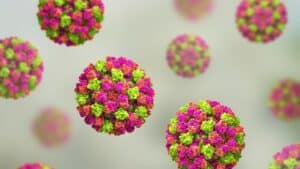Is stomach flu contagious?
Yes, the stomach flu (or norovirus) is highly contagious and spreads easily from person to person.
Norovirus incubation period: How long does norovirus last?
The incubation period of norovirus (the time between exposure to the virus and the onset of symptoms) usually ranges between 1-2 days.
However, an infected person can start spreading the virus even before they start showing symptoms. Plus, they can continue to shed the virus for up to two weeks after recovery, contributing to the contagious nature of the virus.
Norovirus vaccine: Is there a vaccine for the stomach flu?
Currently, there’s no approved vaccine for norovirus. However, several vaccines are in the development and testing stages. The biggest challenge for vaccine development is that there are over 35 different Norovirus types, making it difficult for one vaccine to conquer them all.
Does the flu vaccine protect against the stomach flu?
No, the flu vaccine does not prevent a norovirus infection. This is because the two infections are caused by different viruses.
Norovirus infections are not a type of flu, they are just commonly called the stomach ‘flu.’ The flu shot, on the other hand, protects against the influenza virus.
Rotavirus vs. Norovirus: What are the differences?
The stomach flu or viral gastroenteritis can be caused by different types of viruses, primarily the norovirus and rotavirus. The two viral infections cannot be identified based on symptoms alone; lab tests are needed.
The main differences between rotavirus and norovirus are:
- Rotavirus is a double-stranded RNA virus that looks like a wheel under an electron microscope. Norovirus is a single-stranded RNA virus that is non-enveloped.
- Rotavirus belongs to the Reoviridae family of viruses while norovirus belongs to Caliciviridae.
- Rotavirus is more common in children and norovirus trends to affect adults more.
- There is a rotavirus vaccine but no norovirus vaccine exists.
